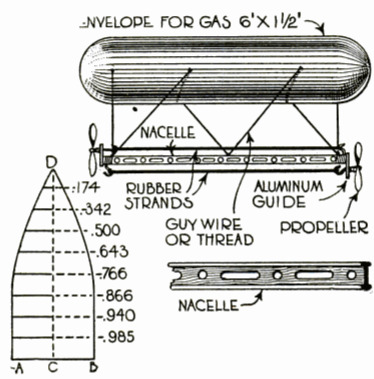How to Construct a Model Dirigible
Contenuto
-
Titolo
-
How to Construct a Model Dirigible
-
Article Title and/or Image Caption
-
How to Construct a Model Dirigible
-
extracted text
-
THE model herein described is a dirigible of the cylindrical type, having semi-spherical ends. The material used to construct the envelope is varnished silk. Its length is 6 ft. and its diameter 13 ft. The silk should be coated with a thin varnish on the interior and exterior surfaces to increase its gas-holding property.
The constructional details of the cylindrical part of the envelope should present no special difficulty. It is best to build the cylindrical portion of this model upon light cardboard. Of course, it is essential at all times to make allowances for overlapping when cutting up the silk, both on the cylinder and the strips making up the ends. The semi-spherical ends may be readily constructed by those familiar with the development of curved surfaces. For amateurs unfamiliar with pattern-drafting, the following solution is offered.
The radius of the envelope being 9 in. and the plan being to employ six strips to an end, we get the maximum circumference equal to approximately 56.7 inches. Dividing the circumference into six parts, we get the base, AB, of each strip. These measurements are laid out to scale on pasteboard. Dividing the circumference by two, we are enabled to get the height, CD, of each strip. The height is divided into nine equal parts, as shown in the figure, and lines drawn parallel to the base. The actual length of the lines may be readily ascertained by multiplying the decimals in the figure by the length of the base. Twelve similar strips, with allowances made for joining, are cut from the silk, using the pasteboard strip as a pattern. The envelope being completed and permitted to dry thoroughly, it is inflated with an air-pump to ascertain whether any leaks exist.
Assuming that it is intended to inflate the model with hydrogen, which has a lifting capacity about twice as great as coal-gas, it is advisable to procure a tank of the gas under pressure. The metallic tank is returnable, and the cost of the gas very small. If coal-gas is used, it may be necessary to obtain a small force-pump to get sufficient pressure. A small valve should be inserted at one extremity of the envelope for purposes of inflation.
In a dirigible of this size a high rate of speed is impossible, and for ordinary purposes undesirable.
As shown in the accompanying illustration, the motor consists of two twisted rubber skeins fastened to a spruce nacelle. The nacelle, which should combine lightness with strength, is made from spruce, although other woods may be substituted. The nacelle is slotted throughout its entire length, as shown, to reduce its weight without unduly decreasing its strength. The thin guy-wires or threads should be strung as shown to afford the most efficient means of propulsion.
The propellers may be fashioned from light wood or metal. They must be arranged one in front and one behind, both being securely fastened to the nacelle by a pair of aluminum guides. Since the actual speed of the dirigible has nothing to do with the model sustaining itself in air, the propellers should be large, though light, and should revolve slowly. It is suggested that they be constructed of thin steel wire and varnished silk to secure maximum lightness. They must be of opposite pitch, and of the same weight and size. The bead bearings should be frequently oiled to reduce friction.
As is the case when air resistance must be taken into account, all of the parts must be neatly and smoothly finished to give the most satisfactory results. —HERMAN NEUHAUS.
-
Autore secondario
-
Herman Neuhaus (writer)
-
Lingua
-
eng
-
Data di rilascio
-
1919-04
-
pagine
-
124-125
-
Diritti
-
Public Domain (Google digitized)
-
Archived by
-
Davide Donà
-
Marco Bortolami (editor)
 Screenshot (281).png
Screenshot (281).png